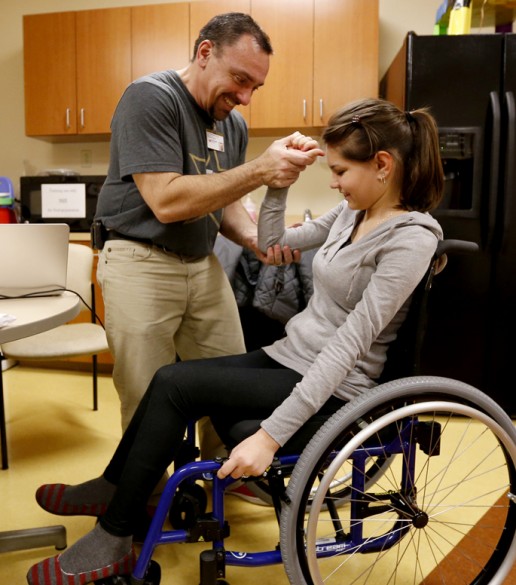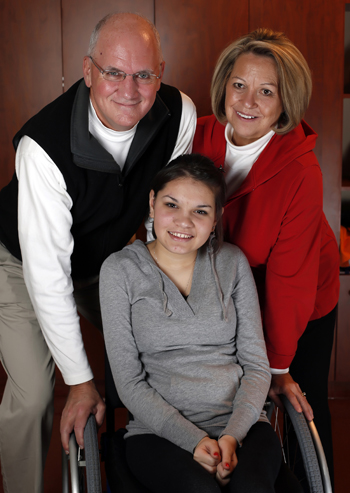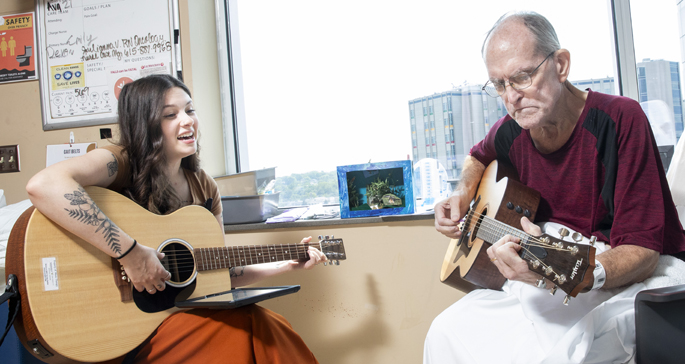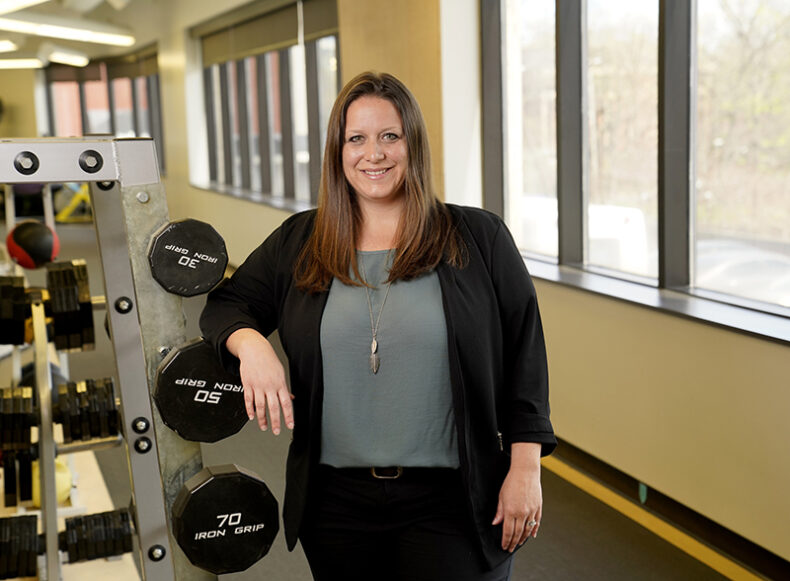by Leslie Hill
Lena Caragherghi lets out a sharp “Ow!” as a physical therapist tests the flexibility of her ankles. “You’re going to break my legs!” the 15-year-old exclaims with a giggle.

Six months ago, Lena came to the United States from Moldova, a developing nation in eastern Europe. A native speaker of Romanian and Russian, the only English she knew was “My name is Lena,” and there were many questions about why the child had slowly lost her ability to walk and was now in a wheelchair.
Now Lena is soaking up English like a sponge and has a diagnosis of spinal muscular atrophy (SMA), a little known genetic disease of motor nerves in the spinal cord.
With the help of her new guardians, Mark and Alva Duke, and SMA expert Bryan Burnette, M.D., assistant professor of Neurology and Pediatrics at the Monroe Carell Jr. Children’s Hospital at Vanderbilt, Lena has a bright future.
The Duke family first visited Moldova eight years ago when their Franklin-based church, Rolling Hills Community Church, decided to focus mission efforts on the country due to its disproportionate share of human trafficking and numerous orphanages.
Both of Lena’s parents died before she turned 6, and she was new to the orphanage when the Duke’s daughter, Ryan, met her and decided to sponsor her. Various Duke family members returned to Moldova nearly every year to do construction work or connect with children in the orphanages, and they would always check on Lena and write her letters from home.
At age 8, she could run around the yard with the other children and only had a slight limp. But by Christmas 2011 she could barely walk 10 steps without extreme effort, and all along the orphanage workers pleaded with the Dukes to take her to the United States and figure out what was wrong. She had seen doctors in Moldova who suspected she had muscular dystrophy, but the country lacked resources to make a firm diagnosis or give her the therapy she needed.
“She deserved a diagnosis,” Alva Duke said. “How do you shut your eyes and go home after that week or two and just forget about her? I had to help.”
They contacted Burnette to get his agreement to evaluate Lena and worked to secure her 10-year visa. Though the Dukes haven’t officially adopted Lena, they have medical power of attorney, and Mark Duke says, “Lena will stay with us for as long as she wants.”
Since her arrival last August, Lena’s days in America have been filled with Rosetta Stone language lessons and medical appointments. She had numerous tests before an MRI showed the telltale wasting of muscles around the bony part of the spine indicative of SMA, and genetic testing confirmed the diagnosis.
“There is a natural process of overproducing motor nerves during fetal development, and then there is a natural pruning process that happens and there’s a complex set of signals that says when it is time to stop pruning,” Burnette said. “The problem with SMA is that the signaling is disrupted. The brakes are bad on that process and the dying off of motor nerves continues to the point that it causes weakness all over the body.”
SMA arises from a defect in the SMN1 gene and occurs in about one in 7,000 births. The disease has a range of severity, with the most severely affected newborns not surviving past age 2, while less severely affected individuals, like Lena, have a slower loss of function and long life expectancy.

There is no treatment for the disease, although Burnette says there is a promising study under way of a molecular “patch” for the defective gene. In mouse studies, the patch is only effective given right after birth.
That’s where Burnette’s research comes in. Though the infants with the severest form of the disease are the ones who need diagnosis and treatment the fastest, they are unable to objectively participate in traditional motor function tests like walking or balance.
“We’re looking for some type of marker, in blood for instance, that can tell us how severe the case of SMA is and give us something to measure in terms of treatment,” Burnette said.
“Ultimately we want to be able to catch SMA as early as possible and know that the treatments we give are working.”
This study is the first under way in the Network of Excellence in Neuroscience Clinical Trials, or “NeuroNEXT,” a national cooperation of academic medical centers for neuroscience research, including Vanderbilt. For these very rare diseases, the network allows the group to enroll more patients in larger clinical trials and complete them more rapidly.
For now, Lena’s only treatment option is physical therapy to keep her function up, but Burnette suspects she may benefit from this research in the future.
“She’s mildly affected enough and has long enough life expectancy that it’s not out of the realm of possibility she could receive a treatment in the future that halts any further progression or even gives some opportunity for improvement,” he said.
“She is going to face challenges and have needs in terms of her physical limitations, but I know young people with SMA who go to college and have careers. All of those things are certainly in Lena’s future.”
Lena is focused on learning English and enjoying her favorite aspects of life in the United States – shopping at Target and singing Justin Bieber songs.
“We had no idea what to do as we watched her deteriorate in Moldova. Folks like Lena don’t have a safety net,” Mark Duke said. “When Vanderbilt accepted Lena as a patient, there was never any expectation of how much care she would get. This has been a great big gift and an answer to many, many prayers.”















